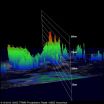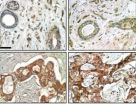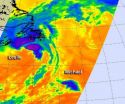(Press-News.org) NASA's Hurricane and Severe Storm Sentinel (HS3) airborne mission sent an unmanned Global Hawk aircraft this morning to study newborn Tropical Depression 14 in the central Atlantic Ocean that seems primed for further development. The Global Hawk left NASA's Wallops Flight Facility on Wallops Island, Va., this morning for a planned 26-hour flight to investigate the depression.
NASA's latest hurricane science field campaign began on Sept. 7 when the Global Hawk flew over Hurricane Leslie in the Atlantic Ocean. HS3 marks the first time NASA is flying Global Hawks from the U.S. East Coast.
According to Chris Naftel, project manager of NASA's Global Hawk program at NASA's Dryden Flight Research Center, Edwards Air Base, Calif., the Global Hawk aircraft took off at 7:06 a.m. EDT and headed for Tropical Depression 14, which at the time of take-off, was still a developing low pressure area called System 91L.
At 1500 UTC (11 a.m. EDT), Tropical Depression 14 was located near 16.3 North latitude and 43.1 West longitude, about 1,210 miles (1,950 km) east of the Lesser Antilles. The depression had maximum sustained winds near 35 mph. It was moving to the west near 10 mph (17 kmh) and had a minimum central pressure of 1006 millibars.
The National Hurricane Center expects Tropical Depression 14 to strengthen into a tropical storm over the next 48 hours, and turn to the northwest.
On Sept. 10, the Tropical Rainfall Measuring Mission (TRMM) satellite passed over Tropical Depression 14, when it was known as low pressure System 91L and data from TRMM's Microwave Imager (TMI) and Precipitation Radar (PR) were used to create a rainfall analysis. The data was overlaid on a combination infrared and visible image from TRMM's Visible and InfraRed Scanner (VIRS) and showed that System 91L was getting organized and that convective storms reaching heights of about 13km (~8.1 miles) were dropping heavy rain to the northwest and northeast of the center of the circulation.
The HS3 mission targets the processes that underlie hurricane formation and intensity change. The data collected will help scientists decipher the relative roles of the large-scale environment and internal storm processes that shape these systems.
HS3 is supported by several NASA centers including Wallops; Goddard; Dryden; Ames Research Center, Moffett Field, Calif.; Marshall Space Flight Center, Huntsville, Ala.; and the Jet Propulsion Laboratory, Pasadena, Calif. HS3 also has collaborations with partners from government agencies and academia.
HS3 is an Earth Venture mission funded by NASA's Science Mission Directorate in Washington. Earth Venture missions are managed by NASA's Earth System Science Pathfinder Program at the agency's Langley Research Center in Hampton, Va. The HS3 mission is managed by the Earth Science Project Office at NASA's Ames Research Center.
INFORMATION:
NASA's Global Hawk investigating Atlantic Tropical Depression 14
2012-09-12
ELSE PRESS RELEASES FROM THIS DATE:
Scrub jays react to their dead
2012-09-12
Western scrub jays summon others to screech over the body of a dead jay, according to new research from the University of California, Davis. The birds' cacophonous "funerals" can last for up to half an hour.
Anecdotal reports have suggested that other animals, including elephants, chimpanzees and birds in the crow family, react to dead of their species, said Teresa Iglesias, the UC Davis graduate student who carried out the work. But few experimental studies have explored this behavior.
The new research by Iglesias and her colleagues appears in the Aug. 27 issue of ...
Protein linked to therapy resistance in breast cancer
2012-09-12
A gene that may possibly belong to an entire new family of oncogenes has been linked by researchers with the U.S. Department of Energy (DOE)'s Lawrence Berkeley National Laboratory (Berkeley Lab) to the resistance of breast cancer to a well-regarded and widely used cancer therapy.
One of the world's leading breast cancer researchers, Mina Bissell, Distinguished Scientist with Berkeley Lab's Life Sciences Division, led a study in which a protein known as FAM83A was linked to resistance to the cancer drugs known as EGFR-TKIs (Epidermal Growth Factor Receptor-Tyrosine Kinase ...
What are the effects of the Great Recession on local governments?
2012-09-12
Freezing positions and cutting workforces
Trimming pension and health care costs and passing them to employees
Lowering service delivery levels, but not imposing many new fees
Using technology to reduce costs where possible
Receiving added pressure but little help from States and the Federal Government
This important new research sheds light on the challenges faced by city and county governments that must provide most basic services. Unlike federal or state governments, these local governments have limited ability to generate revenue and are often mandated to pay for ...
NASA infrared data reveals fading Tropical Storm Leslie and peanut-shaped Michael
2012-09-12
When NASA's Aqua satellite passed over the Atlantic on Sept. 11 it caught Tropical Storm Leslie's clouds over Newfoundland and peanut-shaped Tropical Storm Michael to its southwest. The Atmospheric Infrared Sounder (AIRS) instrument captured infrared data on Tropical Storms Leslie and Michael when it passed overhead on Sept. 11.
Michael Appears Peanut-Shaped on Satellite Imagery
Tropical Storm Michael forecast to become a remnant low later today, Sept. 11, but as of 11 a.m. EDT Michael still had maximum sustained winds near 45 mph (75 kmh). It was located about 1,090 ...
Yellow lights mean drivers have to make right choice -- if they have time
2012-09-12
A couple of years ago, Hesham Rakha misjudged a yellow traffic light and entered an intersection just as the light turned red. A police officer handed him a ticket.
"There are circumstances, as you approach a yellow light, where the decision is easy. If you are close to the intersection, you keep going. If you are far away, you stop. If you are almost at the intersection, you have to keep going because if you try to stop, you could cause a rear-end crash with the vehicle behind you and would be in the middle of the intersection anyway," said Rakha, professor of civil ...
Genetic make-up of children explains how they fight malaria infection
2012-09-12
Researchers from Sainte-Justine University Hospital Center and University of Montreal have identified several novel genes that make some children more efficient than others in the way their immune system responds to malaria infection. This world-first in integrative efforts to track down genes predisposing to specific immune responses to malaria and ultimately to identify the most suitable targets for vaccines or treatments was published in the Proceedings of the National Academy of Sciences by lead author Dr. Youssef Idaghdour and senior author Pr. Philip Awadalla, whose ...
Scientists discover how the brain ages
2012-09-12
The ageing process has its roots deep within the cells and molecules that make up our bodies. Experts have previously identified the molecular pathway that react to cell damage and stems the cell's ability to divide, known as cell senescence.
However, in cells that do not have this ability to divide, such as neurons in the brain and elsewhere, little was understood of the ageing process. Now a team of scientists at Newcastle University, led by Professor Thomas von Zglinicki have shown that these cells follow the same pathway.
This challenges previous assumptions ...
Uncertain about health outcomes, male stroke survivors more likely to suffer depression than females
2012-09-12
Philadelphia, PA, September 12, 2012 – Post-stroke depression is a major issue affecting approximately 33% of stroke survivors. A new study published in the current issue of Archives of Physical Medicine and Rehabilitation reports that the level to which survivors are uncertain about the outcome of their illness is strongly linked to depression. The relationship is more pronounced for men than for women.
"Male stroke survivors in the US who subscribe to traditional health-related beliefs may be accustomed to, and value highly, being in control of their health," says ...
Information theory helps unravel DNA's genetic code
2012-09-12
DNA consists of regions called exons, which code for the synthesis of proteins, interspersed with noncoding regions called introns. Being able to predict the different regions in a new and unannotated genome is one of the biggest challenges facing biologists today. Now researchers at the Indian Institute of Technology in Delhi have used techniques from information theory to identify DNA introns and exons an order of magnitude faster than previously developed methods. The researchers were able to achieve this breakthrough in speed by looking at how electrical charges are ...
Going with the flow
2012-09-12
Scientists who study tissue engineering and test new drugs often need to sort, rotate, move, and otherwise manipulate individual cells. They can do this by prodding the cells into place with a mechanical probe or coaxing them in the desired direction with acoustic waves, electric fields, or flowing fluids. Techniques that rely on direct physical contact can position individual cells with a high level of precision while non-contact techniques are often faster for sorting large numbers of cells. An international team of researchers has now developed a way to manipulate cells ...




